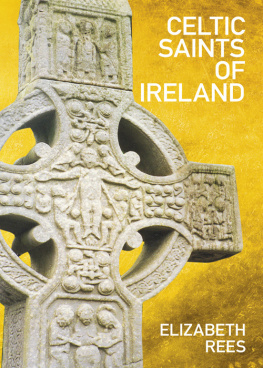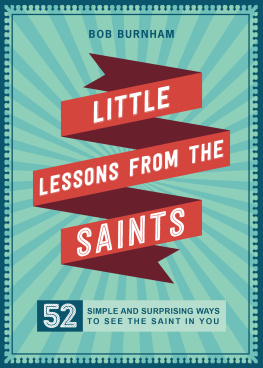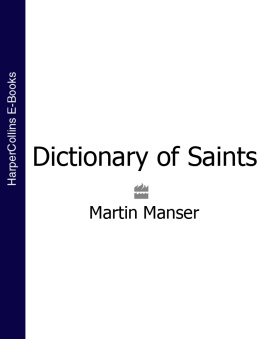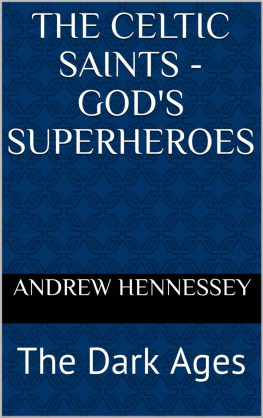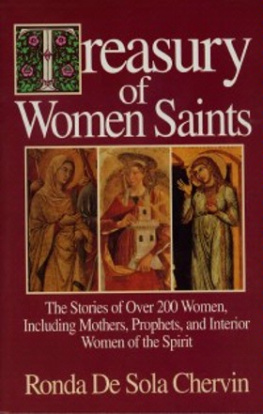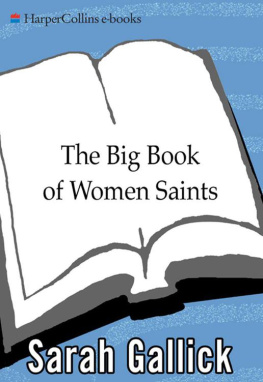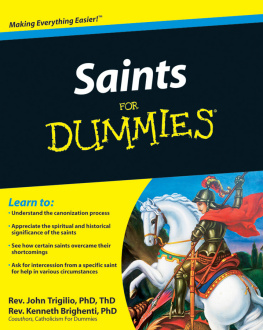CONTENTS
T his book is written as an introduction to the Celtic saints of Ireland. With a very few exceptions, the monks who wrote the vitae, or biographies, of the Celtic saints lived many centuries later. It is therefore impossible to reconstruct the lives of these early monks and nuns, and so we can no longer view them except through medieval eyes. However, archaeology, the study of site, of place names, inscribed stones and early texts offer us clues about how these men and women lived.
As a student I was inspired by Derwas Chitty, who introduced me to the Desert Fathers, and I was held spellbound by the lectures of E.G. Bowen, whose infectious enthusiasm for landscape archaeology and the Celtic saints encouraged generations of scholars to develop and refine his ideas. This led me on a quest to visit the sites where devotion to our early Christian forebears is imprinted on the ground.
I am not primarily a scholar: after leaving Oxford University I entered monastic life, and my approach to the Celtic saints is therefore that of a vowed celibate woman, who has chanted the psalms daily. I have sat in a dark church in the early mornings, listening to hunks of scripture, allowing them to gradually reframe me, for such is the general aim. I know the joys and challenges of living in community alongside other vowed women, and this leads me to ask questions and explore possible answers from within a living tradition.
I read Latin but not Irish: for this I depend on colleagues who advise me. I am fortunate to know Jonathan Wooding, Karen Jankulak and Thomas OLoughlin, and to have met with other scholars along the way. It is quite possible that your favourite saint does not appear in this book, because there are a vast number of early Irish saints. Those wishing to research their local saint are advised to consult Professor Pdraig Riains Dictionary of Irish Saints (Four Courts Press, 2011). Within its 660 pages, almost all the known facts concerning over 1000 saints are accurately documented.
I am grateful to Dr Jonathan Wooding of the Centre for the Study of Religion in Celtic Societies at the University of Wales, Lampeter, for his helpful suggestions. Any errors are my own. I thank Thomas OLoughlin, Professor of Historical Theology at Nottingham University, for permission to quote from his book, Saint Patrick: the man and his works. Thank you also to my sister, Frances Jones, for her two photos of The Seven Churches on the Aran Islands, and for scanning all the remaining photographs, which I took on my travels. My final thank you is to the saints who have enticed me to meet them at home in the beautiful locations where they chose to live.

Map of Ireland, showing sites described in the text.
1
Sainthood
Most of the men and women whom we call the Celtic saints were monks and nuns. What did they think about sainthood? Their viewpoint was different from ours, because most of Church history had not yet happened. There were only four or five centuries of Christian men and women who could serve as models for holy living, and the more heroic among them had been martyred. While early monks and nuns may have read the Acts of the Martyrs, these accounts focussed on a martyrs death, rather than their life; they could not really be imitated.
Again, there were few models to imitate in the gospels: the first followers of Jesus are briefly described, but they are portrayed as disciples, rather than as people in their own right. We learn little about their personal holiness. The scriptures were written before monasteries existed, so where could models of holiness in a monastic context be found? St Paul does describe a Church in which virgins and widows have an accepted place; he does not, however, describe these women as people. To whom, then, did the Celtic saints look for examples of holy living?
Old Testament models
Celtic monks and nuns were deeply influenced by the Old Testament, since they were closer to it in time than we are. They were also, perhaps, better able to understand the mentalities and cultures of those who compiled the books within it. As Christians, of course, the gospels formed the foundation of their spiritual lives, and particular texts were held dear. Jesus had said If you wish to be perfect, go and sell what you own and give the money to the poor, then come, follow me (Mt. 19. 21), and this is what monks and nuns tried to do. They often lived in groups; they came together and listened to the word of God, in order to be perfect, come and follow.
There was a model for this in the Old Testament: the First and Second Book of Kings describe brotherhoods of prophets who lived in the desert in quite large groups. Sometimes it is a group of fifty (2 Kgs. 2. 7; 17), under the leadership of someone wise and experienced, in this case Elijah, and his disciple Elisha, in the ninth century BC . Celtic monks could identify with a community who lived apart from society, under the authority of a holy person. As they listened to passages from scripture, read to them in church, day after day, they could connect with their Jewish-Christian heritage.
They knew that Jesus had pondered on the ministry of Elijah and Elisha, and had copied them too. Like Elisha, Jesus healed lepers, and he raised a widows son to life, as both prophets had done. Luke portrays Jesus challenging the people of Nazareth by likening himself to his two great predecessors:
There were many widows in Israel, I can assure you, in Elijahs day, when heaven remained shut for three years and six months and a great famine raged throughout the land, but Elijah was not sent to any of these: he was sent to a widow at Zarephath, a Sidonian town. And in the prophet Elishas time there were many lepers in Israel, but none of these was cured, except the Syrian, Naaman (Lk. 4. 257).
When Jesus asked his disciples who people thought he might be, they replied: some say John the Baptist, some Elijah or one of the prophets (Mt. 16. 14).
Call to discipleship
Celtic monks would have resonated with the touching description of Elishas unexpected call to leave his family in order to serve God. They would have understood his initial hesitation, followed by his generous response. As Elijah passed by, wearing his cloak of hair and leather loincloth (2 Kgs. 1. 8), he threw his cloak over Elisha, to claim him for God. Elisha appears to have been the model for the rich young man of Matthew 19. 21: as a wealthy farmer, he owned twelve yoke of oxen. Yet unlike the rich man in Matthews gospel who went away sad, for he was a man of great wealth, Elisha responded to Elijahs invitation. Like each Celtic monk, he underwent conversion, and exchanged his yoke of oxen for a life of discipleship under the yoke of a holy man:
[Elijah] came to Elisha son of Shaphat as he was ploughing behind twelve yoke of oxen, he himself being with the twelfth. Elijah passed near to him and threw his cloak over him. Elisha left his oxen and ran after Elijah. Let me kiss my father and mother, then I will follow you, he said. Elijah answered, Go, go back; for have I done anything to you? Elisha turned away, took the pair of oxen and slaughtered them. He used the plough for cooking the oxen, then gave to his men, who ate. He then rose, and followed Elijah and became his servant (1 Kgs. 19. 1921).
The prophets model holiness
The so-called Elijah Cycle (1 Kgs. 17. 1 2 Kgs. 1. 18) and Elisha Cycle (2 Kgs. 2. 1 13. 21) recall the vitae, or Lives of Celtic saints: they were composed long after the deaths of their subjects, but they attempt to convey their core values and their holiness, for the edification of later generations of believers. We read of the miracles of Elijah and Elisha, which are often a compassionate response to the needs of a poor person or a local king. As in the

